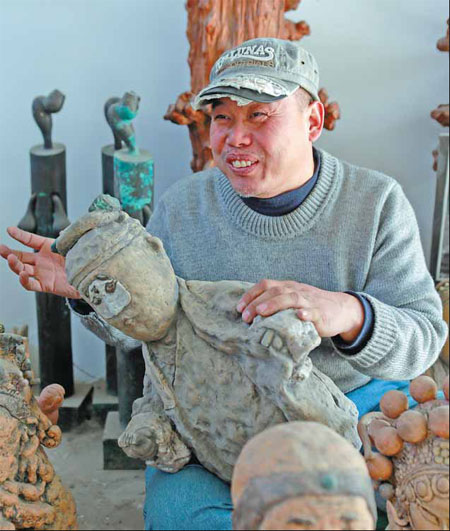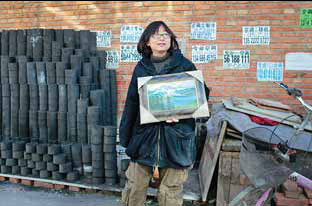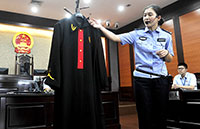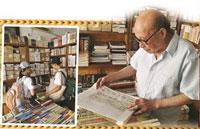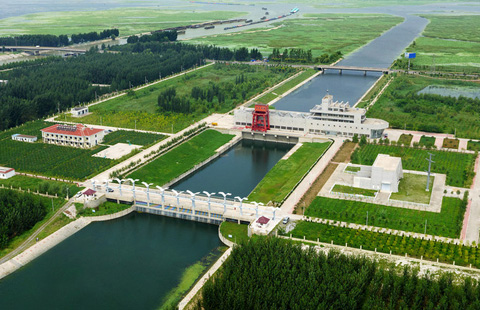Painting a grim picture in Songzhuang
By Zhao Xu (China Daily) Updated: 2012-11-22 08:05
|
Dou Jinjun surrounded by his clay sculptures in his Songzhuang studio. Photos by Feng Yongbin / China Daily |
|
Xu Lili displays her oil paintings outside the room she rents in the village. |
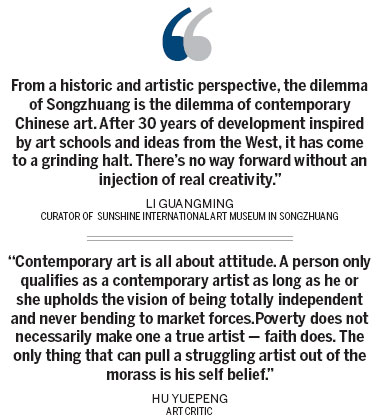
A rural area in eastern Beijing has been home to an artistic community for two decades, but a downturn in the market and the rising price of land is dampening the fires of creativity, reports Zhao Xu.
Three years ago, Dou Jinjun would never have imagined that he would one day be reduced to hawking his artworks outside a bustling open-air antiques market in southern Beijing, hoping to attract a customer or two.
Thanks to the hordes of treasure hunters at the market, passing trade is good. From time to time, a passerby will cast a casual glance, before crouching down to make a closer examination of the rough and humble clay figures, whose barely open eyes and bridgeless noses somehow resemble those of their creator.
Scanning the face of a potential client, Dou typically wears the expression of a man waiting for delivery of a final verdict. Vague interest is always appreciated and before the viewer stands up to leave, Dou invariably hands out a name card, "I'm an artist from Songzhuang," he says. "Come and visit my studio if you ever have time."
The invitation may not always elicit a knowledgeable response in this more "pedestrian" part of the city, but as anyone who has dabbled in contemporary Chinese art will know, Songzhuang in the eastern suburbs of Beijing boasts China's, and most probably the world's, largest colony of artists who consider themselves socially conscious avant-gardists.
Over the past few years, the combined effects of a downturn in the lower-end art market and soaring local land prices have threatened to dampen a creativity that has been burning like wildfire since the first few "art outlaws" settled in the county almost two decades ago. It has also forced the overwhelming majority of the 5,000 artists-in-residence to the very edges of their already hardscrabble existences.
'Peripheral things'
"Galleries have long stopped coming for pictures," said painter An Kun, recalling the heyday of the area and contemporary Chinese art between 2004 and 2007. In those days, An would just sit and paint in his 110-square-meter studio, untroubled by "peripheral things" such as the payment of his annual 20,000 yuan ($3,200) rent. One of his regular patrons was a French gallery owner, who has since opened a space in Shanghai.
The good times didn't last and the art bubble burst amid the so-called financial tsunami of 2008. For those who endured the hardship and anonymity of Songzhuang's first decade, between 1994 and 2004, success arrived unexpectedly and ended abruptly.
However, according to An, who credits Songzhuang for his departure from classical Chinese painting and his adoption of a purely experimental style, one's feelings about the ongoing situation are in large part determined by the original motivation for living in the community. "If you want to breathe art in the air and find real soul mates, Songzhuang is the place to be," said the artist, who returns to his native Jiangsu province in Eastern China several times a year, but only feels ever more removed from his "car-driving, karaoke-singing bourgeoisie friends" back home.
Between 2005 and 2007, the number of artists living at Songzhuang rose from a couple of hundred to more than 2,500. Around 1,500 arrived in the year before the 2008 Beijing Olympic Games to cash in on what many believed would be a golden opportunity.
The envisioned opportunities failed to materialize and many of those who had arrived full of hope found themselves stranded, having spent all the money they had brought from home.
These days, wandering around the 116-sq-km rural area and knocking randomly on the doors of the little brick houses, one is more likely to discover a labyrinth of cramped rooms than an airy atelier. For many artists, a space of less than 10 sq m serves as living area, bedroom and studio combined, the crusted remains of meals sharing the tabletop with squeezed tubes of paint. Rent is usually around 300 yuan a month, but the tenants still struggle to pay that relatively modest amount and buy enough coal to keep Beijing's forbidding winter firmly on the doorstep.
On average, 1,500 artists have come and gone in each of the past three years. Of the 5,000 currently living in the community, only 10 percent to 15 percent are capable of making ends meet solely through the sale of their artworks. The rest rely on handouts from their families or resort to part-time jobs, from painting T-shirts to delivering the mail.
Dou, the clay sculptor, has opted for the "realist" approach to life. He has just accepted an undisclosed sum to design pottery tea sets for use at a friend's newly opened restaurant and will monitor the production of 10,000 pieces. He said that he accepted the commission, at least in part, for the sake of his art.
"With no need to worry about living costs, I'll no longer be under pressure to cater to clients when making real art," said Dou, referring to his primitive-looking sculptures, which are striking but hardly eye candy.
Poverty vs faith
Dou's view was echoed by many of those in Songzhuang, who believe that the question of living has to be resolved before that of art. However, that opinion is likely to meet vehement opposition from Hu Yuepeng, a long time local presence whose tireless documentation of the area - his words filled with pungent criticism and cool wit - has won a loyal following among many local artists.
"Contemporary art is all about attitude. A person only qualifies as a contemporary artist as long as he or she upholds the vision of being totally independent and never bending to market forces," said Hu. "Poverty does not necessarily make one a true artist - faith does. The only thing that can pull a struggling artist out of the morass is his self belief."
But what if the artist is cold and hungry?
"A true artist keeps others moved and inspired by his uncompromising spirit. In return, he receives help from others in times of need," said the critic, who has been a major force behind a campaign to raise funds for a local artist with severe kidney disease.
Although Hu's views may sound idealistic or even puritanical, they point to an important aspect of Songzhuang culture - the brotherhood of artists - which many residents lament hardly exists nowadays. Many yearn for a return to the days when everyone knew everyone else and the sale of a painting would usually result in large meal for the painter and his rejoicing artist friends.
That "warm and fuzzy" era has gone forever, according to Li Guangming, curator of Songzhuang's Sunshine International Art Museum.
"Imagine when a bunch of artists first came to this strange rural place, 24 km from the center of Beijing. They had no one to turn to but each other," he said. "Now we have this two-tier structure with a couple of dozen sitting on top and the rest languishing far below. And if you talk about rich artists helping out poor ones, the immediate question is: which?"
Looking back, Li reckoned that the promise of Songzhuang has always existed, although it means different things to different people.
"The meteoric rise of the few auction-record-breaking Songzhuang artists, such as Yue Minjun and Zhang Xiaogang, between 2004 and 2007 filled many with illusions," he said. "In reality, they (the successes) are and will remain the exceptions. The experimental nature of contemporary art means that its practitioners will have to remain on the fringes.
"From a historic and artistic perspective, the dilemma of Songzhuang is the dilemma of contemporary Chinese art. After 30 years of development inspired by art schools and ideas from the West, it has come to a grinding halt," he said. "There's no way forward without an injection of real creativity."
The curator had some words of warning for aspiring artists heading in his direction: "Think about what you are after. If it's passion, you can find it in your own heart; if it's money, think twice!"
Contact the author at zhaoxu@chinadaily.com.cn
(China Daily 11/22/2012 page6)
- It's anchors aweigh in South China Sea
- Global satellite network planned to boost internet
- Progress in judicial protection of rights
- Hangzhou sees boom in tourism after G20 Summit
- Scientists discuss 'air corridor' of south to north water diversion
- China to assist in SE Asian upgrade
- Navy drill highlights strong ties
- Tianjin mayor suspected of corruption, faces probe
- President Xi congratulates opening of Schwarzman College
- In visit to alma mater, Xi calls for equality
